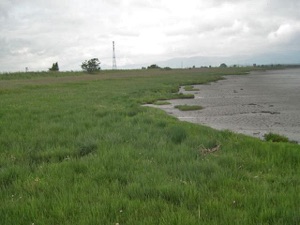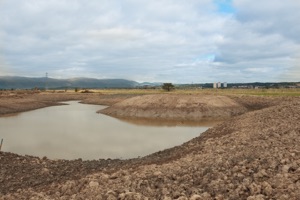Characterising genetic recovery during saltmarsh restoration

Saltmarshes are highly important for UK biodiversity, supporting a high density of invertebrates, and large numbers of wading birds and wildfowl. In addition to their biodiversity value, saltmarshes provide essential ecosystem services to human communities, such as flood defence and control of estuarine nutrient pollution. However, anthropogenic pressures such as agricultural reclamation and improvement schemes have led to a substantial and ongoing loss and degradation of saltmarsh in the UK, while the combination of flood defence barriers and rising sea levels threatens to ‘squeeze’ or further reduce available habitat area. Consequently, saltmarshes are now a priority habitat under the UK Biodiversity Action Plan and the restoration and creation of new saltmarsh is receiving increasing attention.
Numerous saltmarsh restoration projects have been carried out throughout the UK through including Goosemoor (Exe Estuary), Tollesbury (Essex), and Skinflats and Alloa Inches (Forth estuary). Rapid, natural colonisation by saltmarsh plants and invertebrates is typically reported but although these new habitats can resemble natural saltmarsh relatively rapidly, plant community development is often arrested or incomplete.
Part of the RSPB Skinflats reserve following landscaping during saltmarsh restoration


The project is funded by the Esmée Fairbairn Foundation and the University of Stirling and conducted in collaboration with the RSPB. It is expected that this work will generate fundamental information on plant colonisation and saltmarsh community development. However, the ultimate aim is to allow us to better understand the differences between restored and natural saltmarsh systems and their implications for ecosystem stability. By doing this, we should be able to improve the guidelines for restoration practice with the aim that restored saltmarshes should contain more complete communities and best able to withstand the environmental challenges of the future.

Saltmarsh plant biodiversity is key to ecosystem function with species such as saltmarsh grass Puccinellia maritima trapping sediment to build and stabilise the marsh. However, in these low plant diversity communities, diversity within species (genetic diversity) can compensate for the typically low species diversity, resisting disturbance and invasion and maintaining high diversity of saltmarsh invertebrates. Reduced genetic diversity can result in poor population growth and individual fitness, and reduce the long-term sustainability of the population. High genetic diversity in restored saltmarshes may, therefore, be key to ecosystem stability, enabling populations to resist and recover from extreme climatic events driven by ongoing global climatic changes.
In this project we are assessing how rapidly genetic diversity recovers within species when saltmarsh is restored on previously reclaimed sites. We are also looking at how the distribution of diversity differs within natural saltmarsh and restored sites and investigating how diversity, or lack of it can impact ecosystem processes such as decomposition rates. In part of the work we will also look at where colonists come from when marshes are restored and whether elevated diversity within plant species is also correlated with higher diversity of associated animal species.
Greater sea spurry, Spergularia media, a saltmarsh species establishing on the site shown above
Related publications
Fine-scale spatial genetic structure across a strong environmental gradient in the saltmarsh plant Puccinellia maritima. Evolutionary Ecology 29 609-623
Rouger R, Jump AS (2014) A seascape genetic analysis reveals strong biogeographical structuring driven by contrasting processes in the polyploid saltmarsh species Puccinellia maritima and Triglochin maritima. Molecular Ecology, 23, 3158-3170
Rouger R, Vallejo-Marin M, Jump AS (2014). Development and cross-species amplification of twelve microsatellite loci for Puccinellia maritima, an important engineer saltmarsh species. Genetics and Molecular Research, 13, 3426 - 3431
Rouger R, Jump AS (2013). Isolation and characterization of 20 microsatellite loci for the saltmarsh plant Triglochin maritima L. Conservation Genetics Resources, 5, 1157-1158